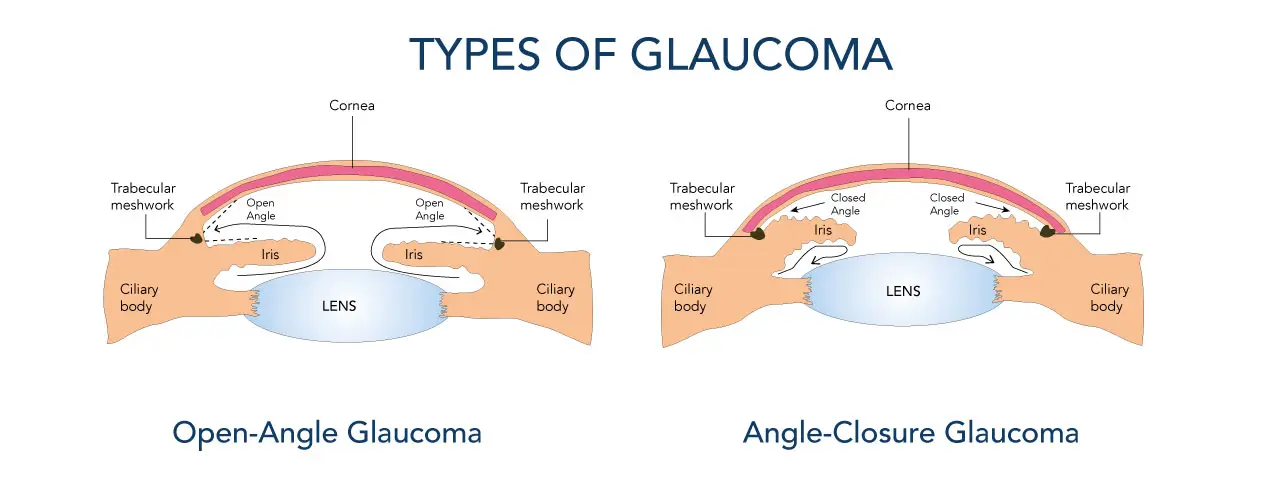The Different Types of Glaucoma
Glaucoma is an eye condition that can lead to vision loss if not treated properly. It is often associated with high pressure inside the eye, which can damage the optic nerve. Understanding the different types of glaucoma is crucial for early detection and effective treatment. This guide will take you through the main types of glaucoma, their symptoms, and available treatment options.
1. Primary Open-Angle Glaucoma (POAG)
What is it?
Primary Open-Angle Glaucoma (POAG) is the most common type of glaucoma. It develops slowly and usually has no symptoms until significant vision loss has occurred.
Symptoms
- Gradual loss of peripheral vision
- Tunnel vision in advanced stages
Treatment
- Eye drops to reduce eye pressure
- Oral medications
- Laser therapy
- Surgery in severe cases
2. Angle-Closure Glaucoma
What is it?
Angle-Closure Glaucoma occurs when the drainage angle in the eye becomes blocked, leading to a rapid increase in eye pressure. This type can be acute (sudden onset) or chronic (slow development).
Symptoms
- Severe eye pain
- Nausea and vomiting
- Blurred vision
- Halos around lights
- Sudden vision loss (in acute cases)
Treatment
- Immediate medical attention
- Medications to lower eye pressure
- Laser therapy to open the drainage angle
- Surgery if necessary
3. Normal-Tension Glaucoma (NTG)
What is it?
In Normal-Tension Glaucoma (NTG), the optic nerve is damaged even though eye pressure is within the normal range. The exact cause is unknown, but reduced blood flow to the optic nerve may play a role.
Symptoms
- Gradual vision loss
- Often detected during routine eye exams
Treatment
- Eye drops to reduce eye pressure
- Monitoring and regular eye exams
- Possible lifestyle changes to improve blood flow
4. Congenital Glaucoma
What is it?
Congenital glaucoma is present at birth and results from abnormal development of the eye’s drainage system. It is a rare condition that requires early intervention to prevent vision loss.
Symptoms
- Enlarged eyes
- Cloudy corneas
- Excessive tearing
- Light sensitivity
Treatment
- Surgery to correct the drainage issue
- Regular monitoring and follow-up care
5. Secondary Glaucoma
What is it?
Secondary Glaucoma is caused by an underlying condition such as eye injury, inflammation, tumor, or advanced cases of cataracts or diabetes.
Symptoms
- Symptoms vary depending on the underlying cause
- Can include pain, redness, blurred vision, and halos around lights
Treatment
- Addressing the underlying cause
- Medications to lower eye pressure
- Laser therapy or surgery, if needed
6. Pigmentary Glaucoma
What is it?
Pigmentary Glaucoma occurs when pigment granules from the iris (the colored part of the eye) clog the drainage system, leading to increased eye pressure.
Symptoms
- Blurred vision
- Seeing halos around lights
- Gradual loss of peripheral vision
Treatment
- Medications to reduce eye pressure
- Laser therapy to clear the drainage system
- Surgery in advanced cases
7. Exfoliative Glaucoma
What is it?
Exfoliative Glaucoma is a type of secondary open-angle glaucoma caused by flaky, dandruff-like material peeling off the outer layer of the eye. This material can clog the drainage system.
Symptoms
- Often asymptomatic until advanced stages
- Gradual loss of vision
Treatment
- Medications to lower eye pressure
- Laser therapy
- Surgery if necessary
Tips for Managing Glaucoma
1. Regular Eye Exams
Early detection through routine eye exams is crucial. Adults over 40 should have their eyes checked every 1-2 years, especially if they have a family history of glaucoma.
2. Take Medications as Prescribed
If you are diagnosed with glaucoma, take your medications exactly as prescribed by your doctor to control eye pressure.
3. Healthy Lifestyle
Maintain a healthy lifestyle with a balanced diet, regular exercise, and avoiding smoking to support overall eye health.
4. Protect Your Eyes
Wear protective eyewear to prevent eye injuries that can lead to secondary glaucoma.
5. Stay Informed
Educate yourself about the condition and stay updated on new treatments and management strategies.
Conclusion
Glaucoma is a serious eye condition that can lead to vision loss if not treated properly. Understanding the different types of glaucoma, recognizing their symptoms, and knowing the treatment options are key steps in managing this condition. Regular eye exams and prompt medical attention can help preserve your vision and maintain your quality of life. If you have any concerns about your eye health, consult with an eye care professional as soon as possible.

